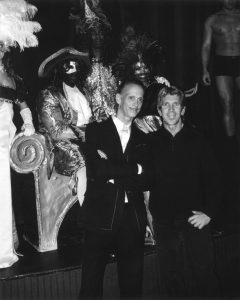From June 23 to September 3, 2017, NOMA will present Pride of Place: The Making of Contemporary Art in New Orleans, an exhibition that celebrates a remarkable selection of paintings, photographs and sculptures recently donated to NOMA by prominent New Orleans art collector and gallerist Arthur Roger. The exhibition’s catalogue will include an interview between Roger and famed American film director, artist, and art collector John Waters whose sculpture and photographs are included in the exhibition. The following is an excerpt of their witty and provocative conversation.
John Waters: You were born in New Orleans and your father drove the Desire streetcar…no wonder you ended up an art dealer! Now, it is just a bus named Desire, which is really pretty depressing! How did you decide to open the gallery?
Arthur Roger: My father had died and I went on my own when I was very young. I found a job working at a print gallery on Royal Street in the French Quarter. I felt an immediate connection to working with artists, and realized almost immediately that I wanted to open my own gallery someday. At 20 years old, not realizing the risk involved, I presumed to ask my mother to mortgage her home in Chalmette so that I could open a small gallery on Magazine Street!
JW: And now you’ve been an art dealer in both New York and New Orleans! You’ve talked about how when you opened your gallery in New Orleans, there were really only a few other serious galleries and very little interest in modern or contemporary art.
AR: At that time in New Orleans, it often felt as if art ended in the 1950s, and contemporary art didn’t exist. When I opened the gallery, it was a real battle to overcome the resistance to contemporary art, although there were a few artists who were starting to develop their own market and audience. Artwork made here was just not valued the same.
JW: New Orleans has obviously gone through its share of upheaval, but somehow the art scene always seems to come out on top and survive. How many of your artists do you feel are distinctive to New Orleans?
AR: Before Hurricane Katrina, New Orleans felt like an island that was disconnected from the rest of the country. The city has such a long cultural history, and there was truly something distinctive about the work being done here. There are few places that compare to New Orleans, and there’s still a quality to this place that draws artists here.
JW: Do you have trouble showing and selling more difficult work? Being from the South, have you ever had censorship battles?
AR: To the contrary. I’ve always felt support for the gallery to take on tough issues. Over the years, we have organized several exhibitions and panel discussions on gender, sexuality, and race, and hosted a lot of events. When I opened the gallery, female artists like Lin Emery and Ida Kohlmeyer had already started to develop a really strong presence in the New Orleans art scene, and the impact of African American artists came a bit later in the gallery’s history. Ida was one of the first artists I approached to show at the gallery, and the other was Robert Gordy. At that time, Robert Gordy was reaching the pinnacle of his career, he was also dying from AIDS, and the gallery helped inaugurate the Art Against AIDS initiative. We also gave Robert Colescott, whose family is from New Orleans, his first New Orleans show in 1990.
JW: You are giving a lot of your collection to a museum, which is what all good dealers want their collectors to do, but it is rarer and rarer these days that people actually do it. When you are selling work to clients, do you think about what they are going to do with their art, where it will end up someday?
AR: I’ve been around long enough that I have seen too many good collections broken apart. In many cases I have played a role in building those collections, and there is something incredibly sad about it. I didn’t want that to happen to my collection.
• • • • • • • •
NOTE: A John Waters Film Festival will be shown in conjunction with Pride of Place on select Fridays in July and August in the Stern Auditorium. All movies start at 7 p.m. and are free to NOMA members; standard admission prices apply to non-members. Click on the movie titles for more information.
- July 21: Pink Flamingos (NC-17)
- July 28: Polyester (R)
- August 4: Hairspray (PG)
- August 11: Cry-Baby (PG-13)
- August 18: Pecker (R)
